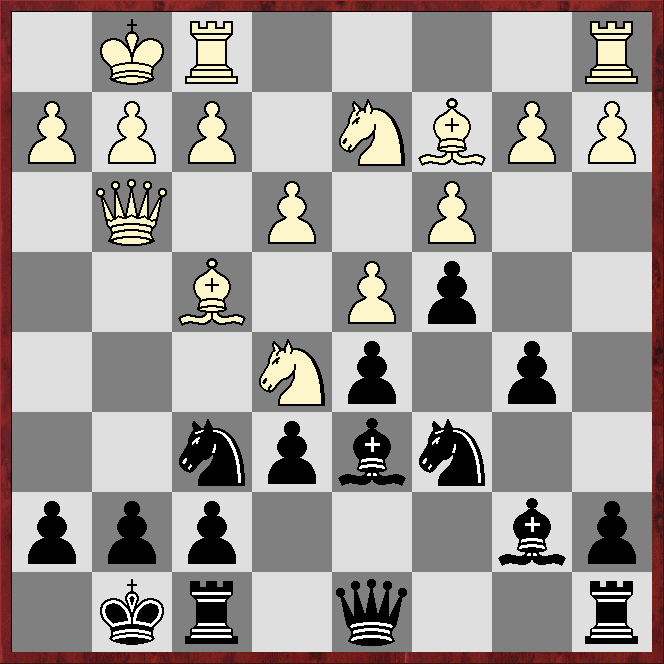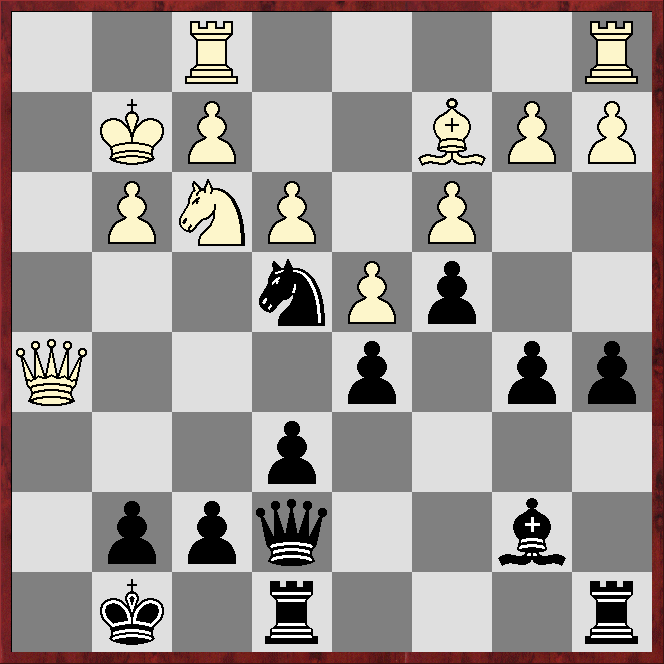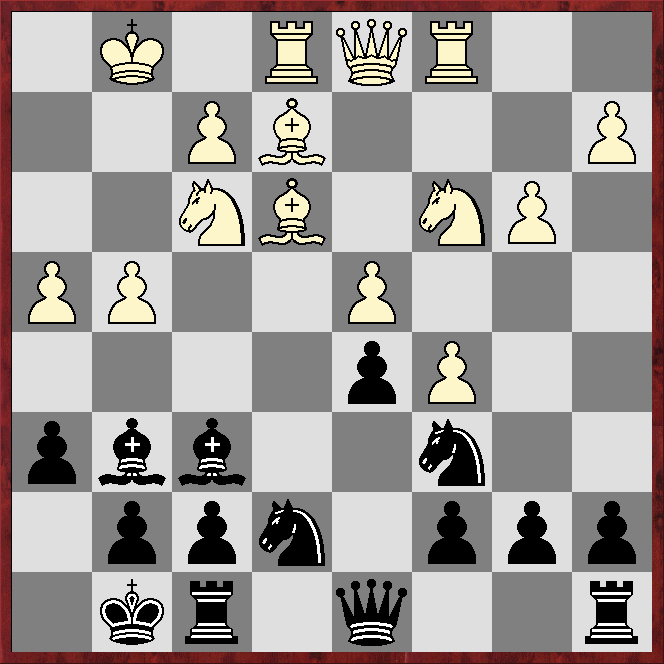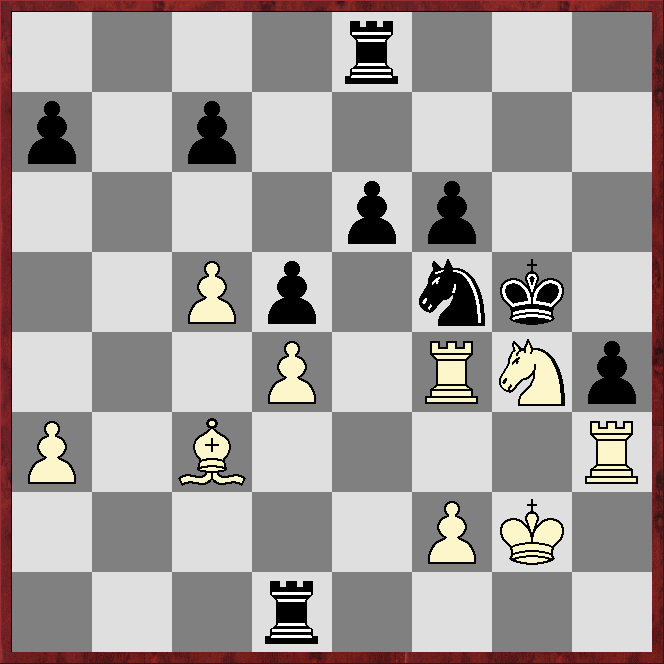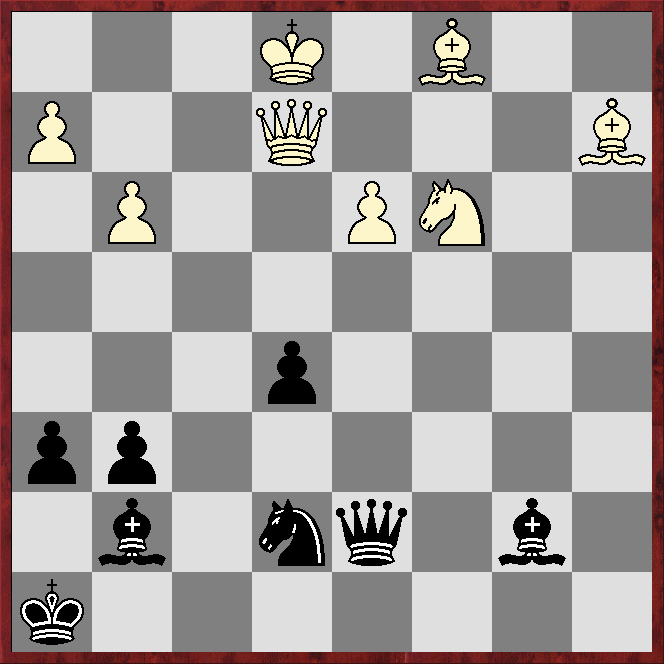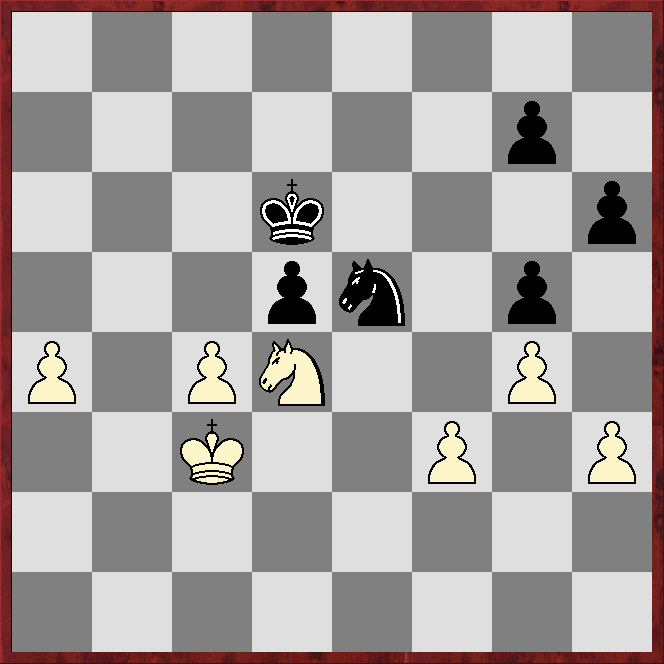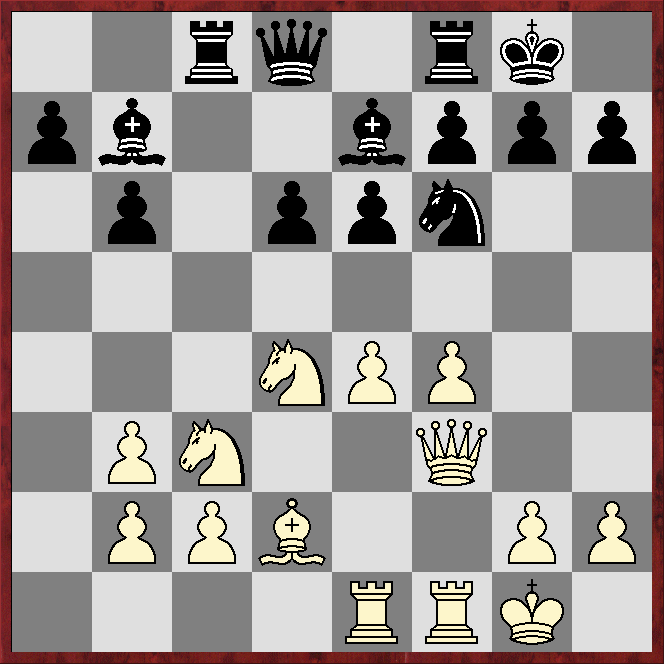I begin this blog after getting back into league chess following many years' absence due to work. My post-job status also means I am able to play more tournament chess. My new club in London is Battersea and my first game for them is on Thursday September 14, 2017. I start with a Fide rating of 1858, an ECF grade of 169 (=1968 elo) and an ICCF correspondence rating of 2267. My current Fide is 1913, my ECF is 1904 and my ICCF is 2330.
Monday, 30 June 2025
Coming Events
THE CzechTour has released details of its tournaments in November (two), January (two) and March-April (one), along with already-released details of tournaments in July-August (three).
Bischofsgrün Round Four
Frank Wagner (1881) - Spanton (1954)
London System
1.d4 d5 2.Nf3 e6 3.Bf4 Bd6 4.e3
Most popular by a long margin in ChessBase's 2025 Mega database is 4.Bg3, but Stockfish17 and Dragon1 fluctuate between the text and 4.Bxd6.
4...Nf6
The main line in Mega25 runs 4...Bxf4 5.exf4 Qd6 6.Qd2 Nf6, when the engines reckon 7.Nc3 gives White a slight edge.
5.Nbd2 b6 6.c3 0-0 7.Ne5!? c5 8.Bd3
*****
*****
*****
*****
8...c4?!
There are positions where ...c4 with tempo is good, and positions where ...c4 with tempo is frowned on as a club-player's move. Here the latter would seem the correct verdict - at least the move is strongly disliked by the engines. They favour the most popular move in Mega25, 8...Ba6, and 8...Qc7.
9.Bc2 Bb7 10.0-0
*****
*****
*****
*****
The main difference between the two sides, in my opinion, is that White it is much better placed than Black for play on the kingside, particularly when the respective light-square bishops are compared. The engines give White the upper hand.
10...b5 11.Qf3!
The engines agree this is better than 11.Bg5, and much better than 11.Ndf3.
11...Nc6 12.Qg3
Even stronger, according to the engines, is 12.Qh3.
*****
*****
*****
*****
If it were White to move, 13.Bh6 would give an advantage, although Black avoids losing material by replying 13...Ne8. Instead 13.Nxc6! wins a piece, eg 13...Bxf4 14.Nxd8 Bxg3 15.Nxb7.
12...Ne7?!
I rejected 12...Nh5 because of 13.Bxh7+ Kxh7 14.Qh3 g6 15.g4, but the engines claim 15...Nxe5 equalises, eg 16.dxe5 f5! 17.gxh5? g5! 18.Qg2!? Rg8 19.Bg3 Bc5, after which Black is a pawn down but has a strong kingside attack. Better is 17.exd6 fxg4 18.Qxg4, but after 18...Nxf4 19.exf4 Qxd6 Black is at least equal, according to the engines.
*****
*****
*****
*****
13.Qf3
13.Nxf7! wins a pawn, eg 13...Rxf7 14.Bxd6 Nf5 15.Bxf5, or 13...Bxf4 14.Nxd8 Bxg3 15.Nxb7.
13...Qc7 14.Qh3
FW offered a draw.
*****
*****
*****
*****
White's kingside attacking chances give at least the upper hand, according to the engines.
14...Ng6?
The engines reckon only 14...h6 prevents White gaining a winning advantage.
*****
*****
*****
*****
15.Nxg6?!
White is slightly better after this, but winning is 15.Bxg6! hxg6 16.Nxg6! fxg6 17.Qxe6+ etc.
15...hxg6 16.Bxd6
Not 16.Bxg6??, trying to enter the line in the previous note, as Black has the simple reply16...Bxf4.
16...Qxd6 17.Nf3 Nh7?
Preventing 18.Ng5, but that was hardly much of a threat as the f6 knight covers h7. Better is using the respite Black has gained from White's kingside pressure to get on with counterplay on the queenside by playing 17...b4.
18.Qg4
The engines reckon 18.Ne5 is even stronger, the idea being to follow up with f4 and g4.
18...Qe7?!
Again the engines prefer ...b4.
19.h4 a5
The engines suggest ...Nf6, either immediately or after ...Bc6.
20.h5!? Nf6
The engines recommend sacrificing a pawn, at least temporarily, by 20...f5!? 21.Qxg6 Rf6 22.Qg3 Rh6, albeit giving White the upper hand.
21.Qg5
Possibly even stronger is the engines' 21.Qh4 gxh5 22.g4.
21...gxh5 22.g3?!
Probably too slow. The engines like 22.Ne5 or 22.g4.
22...Rfe8 23.Kg2 Ne4?
Correct is 23...g6, and if 24.Rh1, then 24...Ne4, while 24.Qh6? Ng4 leaves Black on top, according to the engines.
24.Qxh5
*****
*****
*****
*****
24...g6 25.Qh6 Qf8 26.Qh4 Kg7??
Black should probably try 26...Qg7 or 26...f6, or even 26...Qe7, hoping for a draw by repetition after 27.Qh6 Qf8, but Black can avoid this with 28.Qh3. The text leaves Black in a hopeless position.
27.Rh1 Qh8 28.Qf4 Qg8 29.Bxe4 dxe4 30.Qh6+ Kf6 31.Qg5+ Kg7
Now 32.Ne5, threatening 33.Nd7, followed by 34.Qf6#, and 33.Rh6, followed by 33.Rxg6+!, is so strong that the engines' top choice is offering the bishop by 33...Bc6!?
Instead the game finished:
32.Qh6+ Kf6 ½–½
Collection Growing
Sunday, 29 June 2025
Bischofsgrün Round Three
FACED a Fide Master.
*****
*****
*****
Spanton (1954) - Dieter Seyb (2137)
Nimzowitsch Defence/Alekhine Defence
1.e4 Nc6 2.Nf3 Nf6!?
There are 1,463 examples of this move in ChessBase's 2025 Mega database.
3.e5 Nd5 4.d4
The game began as a Nimzowitsch Defence, but has transposed to a sideline of Alekhine's Defence (333 games reach this position in Mega25), although it is not, as ChessBase calls it, a Four Pawns Attack.
4...d6
*****
*****
*****
*****
5.c4 Nb6 6.exd6 exd6 7.Nc3 Be7 8.Be3 Bg4
This is the commonest continuation in Mega25, but Stockfish17 and Dragon1 are not keen, preferring 8...0-0 or 8...Bf6!?
9.h3 Bh5 10. b3 Bf6!?
The engines strongly dislike this, preferring 10...0-0 or 10...a5.
*****
*****
*****
*****
11.Be2
The engines give 11.g4!? Bg6 12.g5!? Be7 13.h4, claiming White has at least the upper hand (Dragon1) or a positionally won game (Stockfish17).
11...d5?!
Trying to grab a fair share of the centre, but the result is Black is left on the back foot.
12.c5 Nc8
Not 12...Nd7? 13.Nxd5.
13.0-0 0-0
*****
*****
*****
*****
White has a lead in development and more space on the queenside, giving White the upper hand, according to the engines.
14.Rc1 h6 15.Re1 N8e7 16.g4!? Bg6 17.h4!?
*****
*****
*****
*****
17...Qd7!?
The engines reckon this is much better than 17...Nc8 18.g5 Be7 19.Bf4!?, when they give White a winning advantage.
18.g5 Qg4+ 19.Kh2 Bf5?
A better way to give up a piece, according to the engines, is 19...hxg5 20.hxg5 Qh5+ 21.Kg2 Qg4+ 22.Kh1 Qh3+ 23.Nh2 Bxd4, although they agree White is well on top.
20.gxf6 Qh3+ 21.Kg1 gxf6 22.Nh2
Best, according to the engines, is 22.Bf4 or 22.Bf1, but not 22.Bxh6? Kh8 23.Bxf8? (better is 23.Bf1 Rg8+ 24.Bg5, albeit Black has at least an edge after 24...Qg4+ 25.Bg2 fxg5) Rxf8, when Black has a winning attack.
22...Kh7 23.Kh1 Rg8 24.Bf3
This seems better than 24.Rg1 Rxg1+ 25.Qxg1 Rg8.
24...Qxh4
 |
| Now that Black has a second pawn for his missing dark-square bishop, how would you assess the position? |
*****
*****
*****
*****
The position remains sharp, and the white king is somewhat less safe than its black counterpart, but White is winning, according to the engines.
25.Qd2
The engines also like 25.Nxd5!?, continuing 25...Nxd5 26.Bxd5 Rad8 27.Bxc6!? bxc6 28.f3!?, but it looks very risky.
25...Nb4 26.Rg1 Ng6!?
The engines do not like this.
27.Bg4 Bxg4 28.Rxg4 Qh5 29.Rcg1 Qf5 30.R1g3!?
This is Stockfish17's second choice, behind 30.Ne2. Dragon1 also likes 30.Ne2, and 30.Bxh6!?
30...h5 31.Rh3 Rge8 32.Rgg3 h4 33.Rf3 Qe6 34.a3 Nc6 35.Qd3 Kg7 36.Qf5 Nce7 37.Qxe6!? fxe6
 |
| Black's pawn-formation has been improved, but with queens off the board there is less likelihood of a fatal accident in the vicinity of the white king (or the black king for that matter) |
*****
*****
*****
*****
38.Ng4 Nf5? 39.Ne2?
Missing the simple win of a pawn by 39.Nxd5.
39...b6 40.b4
The engines suggest keeping lines closed with 40.c6!?, and if 40...Nge7, then 41.Nf4 Kf7 (41...Nxc6 42.Nxe6+!) 42.Nh5.
40...bxc5 41.bxc5
Here they prefer 41.dxc5!?
41...Rab8 42.Nf4 Nxf4 43.Rxf4?!
Probably better is 43.Bxf4!?, and if 43...Nxd4?!, then 44.Bh6+ and 45.Rxf6(+).
43...Kg6 44.Bd2 Rb1+ 45.Kg2 Rd1 46.Bc3 Kg5
*****
*****
*****
*****
47.Rhf3?
The engines give 47.Rxf5+!? exf5 (47...Kxf5?? 48.Ne3+ and 49.Nxd1) 48.Ne3 Rd3 49.Nxd5 Rxh3 50.Kxh3, when they reckon White's bishop and knight are worth much more than Black's rook and (doubled) pawn. Also better than the text is 47.Ne3 Kxf4 (47...Rd3?? 48.Rg4+ Kh5 49.Nxf5 Kxg4 50.Nh6+ and 51.Rxd3) 48.Nxd1.
47...h3+! 48.Kh2
Forced, as 48.Kxh3?? loses to 48...Rh8+ 49.Kg2 Nh4+ etc.
48...Nh4 49.Nxf6 Nxf3+ 50.Rxf3
*****
*****
*****
*****
50...Re7?
Even worse is 50...Rf8?? 51.Nh7+, but the engines give 50...Rb8, claiming complete equality.
*****
*****
*****
*****
51.Ng8
Best according to the engines, is 51.Ba5!? (they also like 51.c6!?), the idea being 51...Rf7, which they reckon is Black's best reply, can be met by 52.Ne4+!, and if 51...Rxd4, then 52.Bc3! followed by 54.Nxd5!
51...Rh7
Black loses the rook after 51...Rg7?? 52.Rg3+.
52.Rg3+
Possibly better is the engines' 52.Nf6! Rf7 53.Ne4+! Kg6 54.Nd2.
52...Kf5 53.Rf3+ Kg6 54.Rf6+??
Better is 54.c6, intending Bb4 to rescue the knight (Black cannot attack the knight with 54...Kg7?? as it simply escapes with 55.Nf6 or 55.Ne7.
54...Kg7 55.Rxe6 Kxg8
 |
| White has no compensation for the exchange, and in an ending with lots of open lines for the rooks, and weak pawns for the rooks to target |
*****
*****
*****
*****
56.Rg6+ Kf7 57.Rg4 Rd3 58.Rg3?!
Hastening the finish.
58...Rxg3 59.fxg3 Kg6 60.Bd2 Kf5 61.Bf4 c6 62.a4 Kg4 63.a5 a6 64.Bd6 Rb7 0-1
This ended my seven-game unbeaten streak.
Bischofsgrün Panoramaweg
Saturday, 28 June 2025
Bischofsgrün Round Two
FACED an American.
*****
Bob Wheat (1786) - Spanton (1954)
King's Indian Attack/Sicilian Closed
1.Nf3 c5 2.g3 Nc6 3.Bg2 g6 4.d3
 |
| At this point ChessBase calls the opening: "B25: Closed Sicilian: 3 g3, lines without early Be3" |
*****
*****
*****
*****
Black is certainly using a Sicilian-style setup, but without White playing 1.e4 it seems strange to refer to the opening as a Sicilian. White's move-order is typical of the King's Indian Attack, although a case could be made for calling the opening a Reversed Pirc.
4...Bg7 5.e4
Now a Sicilian classification seems much more appropriate.
5...d6 6.0-0 e5 7.Nc3 Nge7 8.Nh4!?
There are 184 examples of this move in ChessBase's 2025 Mega database, but more popular are 8.Be3 and especially 8.Nd2!?
8...0-0
*****
*****
*****
*****
Black has more space on the centre-queenside, but a hole at d5, although White's pieces are not well-placed to exploit the hole. Dragon1 gives Black a slight edge, but Stockfish17 is less sure.
9.Kh1!?
This is a typical move when planning to push the f pawn, but here it is far from clear the move is needed as Black cannot do much on the a7-g1 diagonal.
9...Nd4 10.f4
*****
*****
*****
*****
10...f5!?
The engines reckon best is 10...exf4 11.Bf4 (11.gxf4 f5) h6 12.Be3 g5 13.Nf3 Bg4, all of which was played in Kevin Sturm (1884) - René Dausch (2378), Einhausen Ried (Germany) 2010, when Black went on to win.
The text, which may be a novelty, is strongly disliked by the engines.
*****
*****
*****
*****
11.exf5
The engines reckon 11.fxe5 dxe5 12.Bg5 gives White at least a slight edge.
11...Nexf5 12.Nxf5 Nxf5 13.Bd5+ Kh8 14.Rb1 Rb8 15.a4 a6 16.Ne4?!
Eyeing the g5 square, with hopes of Nf7+, but there is a flaw.
*****
*****
*****
*****
16...h6
This is good enough for a slight edge, according to the engines, but they much prefer 16...Ne7, after which White's light-square bishop must retreat to the queenside, or allow itself to be exchanged - either way, the white king's position is weakened, and ...Bh3 is coming.
17.c3 b5 18.axb5 axb5 19.b4?!
Probably too ambitious. The engines suggest 19.Nf2, but much prefer Black.
19...Ne7 20.Ba2 Bb7 21.Kg1?!
Unpinning the knight, but hardly improving the safety of the king.
21...cxb4 22.Qe2!?
The engines give 22.cxb4 Qb6+ 23.Kg2 exf4 24.Bxf4 Qd4, but reckon Black is winning.
22...bxc3 23.fxe5 Rxf1+ 24.Kxf1!? dxe5 25.Rxb5 Qd7 26.Rc5 Rf8+ 27.Ke1!?
Probably safer is 27.Kg2, but the engines reckon Black's advantage is worth in the neighbourhood of a rook.
27...Rc8?!
This gives up a lot of Black's advantage, whereas 27...Nf5 or 27...Nc6 leaves Black winning easily, according to the engines.
*****
*****
*****
*****
28.Rxc3??
After 28.Rxc8+ Qxc8 29.Bc4 Black has only a slight edge (Stockfish17) or at best the upper hand (Dragon1).
As I made my reply, BW offered a draw.
28...Rxc3??
Missing the win of a piece by 28...Bxe4 29.Rxc8+ Qxc8, after which White cannot both capture on e4 and protect c1.
29.Nxc3
BW, again in my time, said his previous draw offer still stood.
*****
*****
*****
*****
Material is level, and both players have an isolated pawn. The engines reckon the game is equal, but I suspect most humans would look at the exposed white king and conclude that, even if chances really are equal, Black's position is easier to play.
29...Qc6 30.Bb2 Qh1+ 31.Kd2 Bf3 32.Qf2 h5
*****
*****
*****
*****
33.Kc2?
The engines reckon giving up a pawn by 33.Ne4!? Bxe4 34.dxe4 Qxe4 leaves Black with at best a slight edge, while 33.Ne2 is completely equal, and if 33...Bh6+, then 34.Kc2.
33...Nc6 34.Ba3?
This is the engines' second choice, but they reckon much better is 34.Kb3, albeit accepting that 34...Bd5+ gives a winning advantage, eg 35.Ka3 Bxa2+ 36.Nxa2 Qd5 37.Nc1 Bh6 38.Qb6 Bxc1 39.Bxc1 Qxd3+. If in this line White tries 36.Kxa2, then 36...Nb4+ and 37...Nxd3.
34...Nd4+ 35.Kb2 Bh6
White has no defence to the threat of ...Qc1+.
36.Bc4 Qc1+ 37.Ka2 Qxc3
The game finished:
38.Bb2 Qa5+ 39.Kb1 Qb4 40.Ka2 Qa4+ 41.Kb1 Qd1+ 42.Ka2 Qe2 43.Qg1 Bd2 44.Qb1 Bc3 0-1
Friday, 27 June 2025
Bischofsgrün Round One
Spanton (1954) - Reinhold Winter (1789)
*****
French Exchange
1.e4 e6 2.d4 d5 3.exd5 exd5 4.Nf3 Nf6 5.Bd3 Be7 6.0-0 0-0
*****
*****
*****
*****
*****
7.Bg5 Bg4 8.h3 Bh5 9.Nbd2 Bg6!?
This has been played by a 2420.
10.Bxg6 fxg6?!
But this seems to be a novelty, and probably not a good one, as, although it half-opens the f file for the black king's rook, it weakens e6.
11.Qe2!? c6?
There is no time for this. Stockfish17 and Dragon1 suggest 11...Nc6, 11...Qd6 or 11...h6.
12.Rfe1!?
White has the upper hand after this, according to the engines, but even stronger is 12.Qe6+ Kh8 13.Ne5 Qe8 14.Rfe1 with pressure.
12...Bd6 13.Ne5?!
Almost certainly better is 13.Qe6+ Kh8 14.Ne5 Qc7 15.Bf4!?
13...Na6?
Black should play 13...Qc7 or 13...Re8.
14.Nxc6!
This wins a pawn, without risk.
14...bxc6 15.Qxa6 Qb6!? 16.Qxb6 axb6 17.Re6 Ne8!?
The engines slightly prefer 17...Rad8.
18.Rae1 h6 19.Be7!? Bxe7 20.Rxe7 Nf6 21.a3 Rfe8!? 22.Rxe8+ Rxe8 23.Rxe8+ Nxe8
*****
*****
*****
*****
Winning, according to the engines - the equivalent of more than a piece ahead.
24.f3 Kf7 25.Kf2 Nd6 26.c3 b5 27.b3 Ke6 28.g4!? g5 29.Ke3 Nb7 30.a4 bxa4 31.bxa4 Na5 32.Kd3 Kd6 33.c4 c5!? 34.Kc3 Nc6 35.dxc5+ Kxc5 36.Nb3+ Kd6 37.Nd4 Ne5
*****
*****
*****
*****
38.cxd5?
Suddenly the win is gone, whereas 38.Nf5+ Kc5 39.cxd5 Kxd5 reaches the same position as in the game, but with White rather than Black to play, and that makes all the difference. Also winning, according to the engines, is 38.Nb5+!? Kc5 39.cxd5 Kxd5 40.Nc7+ Kc6 (40...Kc5 41.Ne6+ and 42.Nxg7) 41.Ne6, when Black cannot play 41...Nxf3+ as White has 42.Nd4+ etc.
38...Kxd5 39.Nf5
Or 39.a5 Kc5 40.a6 Kb6 41.Kd2 Kxa6 42.Ke3 Kb6 43.Ne6 Kc6 44.Nxg7 Kd5 45.Nf5 Nf7, after which the black knight will eventually be sacrificed for the last white pawn.
39...Nxf3 40.Nxg7 Ng1 41.Nf5 Nxg3 42.Kb4!? Kc6
The only move that draws, but obvious enough.
43.a5 Nf4 44.Kc4 h5!? 45.Nd4+ Kb7 46.gxh5 Nxh5 47.Kb5
 |
| The position is so drawn that the Syzygy endgame tablebase shows only one possible Black move loses |
*****
*****
*****
*****
47...Nf6
The losing move is 47...Ng3?, when 48.a6+ Ka7 49.Ka5! (only winning move) Ne4 50.Nb5+ Ka8 51.Kb6 g4 52.Nc7+ Kb8 53.a7+ wins.
48.a6+ Ka8
RW offered a draw in my time.
49.Ne6 g4 50.Kb6 Nd5+ 51.Kc5 Ka7 52.Kxc5 ½–½
Thursday, 26 June 2025
Getting There (Bischofsgrün)
CAUGHT German Airways' 08:40 from London City to Amsterdam, connecting to a further flight to Nürnberg (Nuremberg).
Meanwhile, the number of entries for the tournament, which encompasses the seniors' championship of Upper Franconia, has climbed to 58 (the tournament is for players aged 55+, although only someone 60+ can become Upper Franconian senior champion).
The connecting flight turned out to be on the same plane, with the same cabin crew, so I could have been saved the effort of disembarking and reembarking (the same goes for my hold luggage).
Be that as it may, from Nürnberg I caught the metro to the city's main station, and from there a train to Bayreuth, where I planned to get a bus to complete my journey to the venue-hotel on the outskirts of Bischofsgrün, a year-round resort in the Fichtel Mountains.
However, as I left Bayreuth station, I bumped into the tournament organiser, Jürgen Wempe of ChessOrg.de, who was there to give a lift to another competitor, and Jürgen offered to drive me as well.
 |
| Hotel Kaiseralm - we arrived about 17:30 central European time |
Summer Club: Round Eight
AM playing in a summer daytime tournament organised by Surrey's Coulsdon Chess Fellowship. It takes place on 10 Wednesday afternoons, the time control being 90 minutes with a 30-second increment.
*****
Spanton (1940 ECF/1954Fide) - Michael Woolley (1258 ECF/1466 Fide)
Queen's Fianchetto Defence
1.d4 b6 2.e4 Bb7 3.Bd3 e6 4.f4!?
Stockfish17 and Dragon1 do not like this.
*****
*****
*****
4...d6
Most popular in ChessBase's 2025 Mega database is 4...Nf6, but the engines prefer 4...c5 or 4...d5.
5.Nf3 Nf6 6.Nc3 Be7 7.0-0 Nbd7 8.Qe2 c5?!
The engines strongly dislike this, suggesting 8...0-0.
9.e5 Nd5 10.Ne4 Nb4?
Better is 10...0-0!? or 10...dxe5.
11.Nxd6+
This is good enough for the upper hand, according to the engines, but they reckon even stronger is 11.exd6 Bf6 12.Bb5!?
11...Bxd6 12.exd6 Nxd3 13.Qxd3 cxd4 14.Qxd4 0-0
*****
*****
*****
*****
White is up a pawn, which is passed, has a lead in development and has more space - all in all, a winning advantage, according to the engines.
15.Ne5?!
The engines much prefer 15.b3 or 15.c4.
15...Rc8 16.c4 Qf6?!
The engines reckon that after 16...f6 or 16...Nc5 White has, at best, the upper hand, although no longer winning.
17.Be3 Nxe5?! 18.fxe5
Now the passer is protected.
18...Qg6 19.Rf2
This is probably better than creating kingside light-square weaknesses with 19.g3?!
19...Qe4?
With queens off the board, White's passed pawn becomes even more of a threat.
20.Rad1 f6!? 21.exf6 Rxf6 22.Qxe4 Bxe4 23.d7 Rd8 24.Bg5
 |
| Black is about to go down the exchange and a pawn, and without hope of reaching an ending of opposite-coloured bishops |
*****
*****
*****
*****
The game finished:
24...Bc6 25.Rfd2 Kf7 26.Rd6 Bb7 27.b4 h6!? 28.Bxf6 gxf6 29.c5 bxc5 30.bxc5 Bd5 31.c6 Ke7 32.c7 Rxd7 33.c8=Q Rxd6 34.Rc1
MW now picked up his king, used it to 'capture' my queen, and resigned.
Wednesday, 25 June 2025
Seniors' Championship
AM making final preparations for traveling to Bischofsgrün in the southeast German state of Bavaria.
I have entered the seniors' championship of Upper Franconia, a ChessOrg.de tournament for players 55+ (although only players 60+ can claim the title of Upper Franconian senior champion).
The first round on Friday is at 14:30, followed by eight morning rounds at 09:00.
There are 55 entries, and the time control is 40 moves in 100 minutes, with 30 minutes to finish and a 30-second increment throughout.
 |
| The hotel venue, as I discovered last year, is near the source of the White Main, although in its early stretches it could easily be mistaken for its cousin the Red Main |
Tuesday, 24 June 2025
Lessons From Munich: Clerical Reform
I WAS pleased to reach the following late-middlegame position in my last-round game at Munich.
*****
*****
*****
*****
*****
*****
*****
White has more space and has the better minor piece for cooperating with rooks.
But the bishop is bad (six of seven white pawns are on light squares), and the black knight should have few problems reaching a stable and useful outpost.
Bearing all the above in mind, I headed for a knight-v-bishop ending by exchanging rooks: 19...Rxc1!? 20.Rxc1 Rc8.
After the further moves 21.Rxc8+ Nxc8 I thought I would have decent winning chances.
However, Stockfish17 reckons White is slightly better, while Dragion1 gives White the upper hand.
One thing I failed to properly take into account is that the white king has an easier route to the centre of the board than its black counterpart.
At least as important, I believe, is that, while the bishop is undoubtedly bad, it can be made good - there is little to stop White advancing his g, f and e pawns on to dark squares.
This is basically what happened in the game, the following position being quickly reached.
*****
*****
*****
*****
Luckily for me - the engines reckon White has a won game (I give one line here) - KS accepted my offer.
LESSON: unlike a bad egg, a bad bishop can be improved.
Monday, 23 June 2025
Lessons From Munich: Aiding The Enemy
MY round-six game reached the following position after 45 moves.
*****
*****
*****
*****
*****
*****
*****
I played 46.b4?, which helps Black by making it easy to create a passed pawn, and so the position changes from winning for White to completely equal, according to Stockfish17 and Dragon1.
Instead 46.f4 leaves White the equivalent of at least a minor piece ahead (Stockfish17) or even the equivalent of a rook ahead (Dragon1).
A sample line runs 46...Kc5 47.g5 Kd4 48.gxh6 gxh6 49.Kf6 c5 50.Kg7 Nd7 51.Kxh6 c4 52.bxc4 bxc4 53.Bxc4!? and wins.
LESSON: rival pawn-majorities in an ending are in a race to create a passed pawn, so taking time out from your own race to help the opponent reach the finishing line is just about the last thing you want to do.
Sunday, 22 June 2025
Lessons From Munich: Remember The Classics
IT is fashionable in some quarters to pooh-pooh the application of rules in chess.
*****
By "rules" is meant guidelines or maxims, rather than laws - the latter can also be criticised, but have to be followed (unless, and until, they are changed)!
The rules in question are the likes of: rooks belong behind passed pawns; open a position if you have two bishops and your opponent does not; do not move a piece a second time until all your pieces have been moved once; develop knights before bishops; do not play your queen's knight in front of your c pawn in closed positions; knights on the rim are dim; a bishop on c4 is never a bore.
OK, I made the last one up, but I am sure you get the idea.
American international master John Watson has argued - principally in Secrets Of Modern Chess Strategy, which I am paraphrasing, accurately, I hope - that chess is rule-independent as the exceptions to many rules are as numerous, or nearly so, as the occasions when they apply.
If you have not heard of this argument before, and are throwing your arms up in disgust at the thought of having to go back to the drawing-board with regard to your chess thinking, remember many a villain's words to 007: "Not so fast, Mr Bond."
For Watson's writings have provoked a reaction, not least from Danish-Scottish grandmaster Jacob Aagaard, who argues, for example in Excelling At Chess (again I am paraphrasing), that chess is very much rule-dependent as it is the existence of such maxims that form a starting point for analysis, without which we would be analysing at random.
Two things you can be fairly sure of:
1. Both authors will feel I have not done their arguments justice;
2. The truth probably lies somewhere between the two polarities.
Anyway, the relevance of this to my tournament at Munich can be seen in my round-five game in which the following position arose after 13 moves of a Sicilian Scheveningen.
*****
*****
*****
*****
The game continued 14.f5?! e5 15.Nde2, bringing about the following position.
 |
| Black played 15...Rc5?, but after 14.Be3 Rc8 15.Rd1 he had lost much of his advantage, so what should have been played? |
*****
*****
*****
*****
I suspect most readers of this blog - 1,357 of you yesterday, according to Blogger - will have suggested 15...d5, a classic example of countering a flank attack by advancing in the centre.
Stockfish17 and Dragon1 agree with that choice, claiming Black has a positionally won game.
LESSON: rules, guidelines, maxims - call them what you will, but remember they often do apply, and can be a shortcut to finding the correct continuation.
Saturday, 21 June 2025
Lessons From Munich: You Can't Get Blood Out Of A Stone
IN round four I was offered a draw in the following position.
You do not have to be an engine to realise the game is completely equal, nor a psychologist to work out that the chances of forcing a similarly rated opponent into a decisive error are virtually zero.
 |
| White has just played 48.Kh2-g2 in Bernhard Solger (1866) - Spanton (1954) |
But I played on, hoping against hope to somehow conjure up a win, during the course of which my king moved away from the pawns, and I blundered horribly to lose the game.
LESSON: sometimes you have to stop being a glass half-empty person and accept that a game is drawn.
Friday, 20 June 2025
Lessons From Munich: One Is Not Enough
SHORTLY before the tournament I was casually reading, in a book, I believe, but it might have been a magazine, about the need for the inferior side in an ending to have two weaknesses to make a win possible.
[Clearly we are not talking about positions that are trivially won thanks to an overwhelming preponderance of material.]
Black is a pawn down, and it is a protected passed pawn, but this is only a single 'weakness'.
This 'principle of two weaknesses' is not a new idea - I had heard of it before, although, I have to confess, without paying it much heed.
What made this reference particularly memorable to me was that the author regarded the opponent being a pawn down as just a single weakness, for which a second weakness would usually be needed to covert the position into a win.
I am fairly sure I had not realised this before, but the maxim was brought home to me in my round-three game in the Munich 60+ seniors.
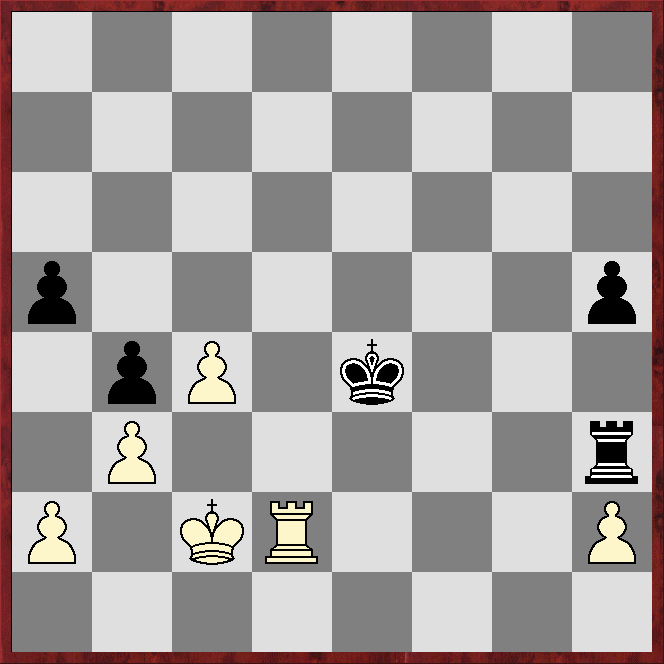 |
Black has just played 45...b5-b4 in Spanton (1954) - Adam Wilczyński (1617) |
It is easy to see Black has no other weaknesses - both black pieces, for example, are more active than the white ones.
Stockfish17 and Dragon1 reckon the position is completely equal, ie 0.00.
I played what is White's only sensible move, 46.Kb2, after which Black has several moves that hold the draw.
The two most obvious are 46...Rf3 and 46...Ke5, both of which prepare for White pushing the passer.
As I explained in my notes to the game, after 46...Rf3 White can play 47.Rc2, but 47...Rf6 prepares to meet 48.c5 with 48...Kd5, after which the c pawn falls.
After 46...Ke5 White can again play 47.Rc2, but both 47...Kd6 and 47...Rf3 suffice to draw. Instead, 47.c5 can be met by 47...Rc3 48.Rc2 Rxc2+ 49,Kxc2 Kd5 50.c6 Kxc6 51.Kd3 Kd5 52.h4 Ke5.
However, my opponent chose 46...Ke3?, creating a second weakness as now the black king is misplaced.
The game finished quickly: 47.Rc2 Kd4 48.c5 Rc3?! 49.c6 Kd5 50.c7 1-0
A better try would have been 48...Rf3, but 49.c6 Rf8 50.c7 Rc8 leaves Black lost, eg 51.Rc4+ Kd5 52.a3! bxa3+ 53.Kxa3 Kd6 54.Ka4 etc.
LESSON: the 'principle of two weaknesses' is well worth bearing in mind in an ending, whether you are the superior side striving to force a second weakness on your opponent, or the inferior side trying to hold on for a draw.
Thursday, 19 June 2025
Summer Club: Round Seven
AM playing in a summer daytime tournament organised by Surrey's Coulsdon Chess Fellowship. It takes place on 10 Wednesday afternoons, the time control being 90 minutes with a 30-second increment. I missed round six as I was playing in a tournament in Munich.
*****
Salvatore Fazia (1267 ECF/1457 Fide) - Spanton (1940 ECF/1954 Fide)
Scandinavian
1.e4 d5 2.e5!?
This move has a poor reputation, largely, I suspect, because everyone 'knows' White's best move is 2.exd5. However, the text is far from being bad, and has the merit of probably putting blacks on their own resources.
2...c5 3.Nf3 Nc6 4.c3 Qc7 5.d4 Bf5
Stockfish17 and Dragon1 do not like this, preferring 5...Bg4 or 5...cxd4.
*****
*****
*****
*****
6.Bf4
The engines reckon White is better after 6.dxc5!? e6 7.b4.
6...e6 7.Nbd2 Nge7 8.Nh4?
The engines give 8.dxc5 Ng6 9.Be3 as equal.
*****
*****
*****
*****
8...cxd4
Black is now winning, according to the engines.
9.Rc1
The engines prefer 9.Ndf3 or 9.Nxf5.
9...d3?
This throws away most of Black's advantage, whereas 9...dxc3 10.Rxc3 h6 11.Nxf5 Nxf5 keeps a winning advantage, according to the engines.
10.Nxf5 Nxf5
The engines reckon 10...exf5!? is slightly better.
11.Bxd3 Nxe5!? 12.Bxb5+ Kd8
 |
| The bishop-pair and Black's loss of castling rights give White more than enough for a pawn, according to the engines |
*****
*****
*****
*****
13.Nf3
The engines suggest 13.g4!?
13...Bd6 14.Nd4?
Correct is 14.Bxe5 Bxe5, and either 15.0-0 or 15.Bd3, according to the engines.
14...Nxd4 15.cxd4 Qa5+ 16.Bd2
Best, but losing.
16...Qxb5 17.dxe5 Bxe5 18.Rb1?!
Passivity, when two pawns down, does not help.
18...Ke7 19.a4 Qc4 20.Rc1 Qe4+ 21.Qe2 Qxe2+
Possibly even better is 21...Qxg2!?, but there is no need to encourage complications.
22.Kxe2 Rhc8 23.Bc3!?
Keeping rooks on, but allowing more weaknesses.
23...Bxc3 24.bxc3 Rc4 25.a5 Rac8 26.Kd3!? d4 27.Rc2 Rxc3+ 28.Rxc3 dxc3 29.Kc2 Rc5 30.Ra1 Kd6 31.a6!? b5 32.Rd1+ Kc7 33.Rd3 b4 34.Kc3?!
Speeding the end.
34...c2 0-1
Wednesday, 18 June 2025
Lessons From Munich: Long Live The King!
IN round two my opponent offered a draw in the following position.
The game is completely equal, according to Stockfish17 and Dragon1.
 |
| White has just played 20.Be2-f3 in Andreas Moser (1768) - Spanton (1954) |
But I suspect grandmaster Nigel Davies would be among those who would prefer to have the black pieces.
Why? Because Davies stresses in his publications that the No1 factor in chess is king safety, and there can be little doubt that in the diagram the black king, being behind unmoved pawns, is safer than its white counterpart, whose pawn-protection has been compromised.
All of which helps explain, if not excuse, why, in the game just three moves later, White was completely lost - the equivalent of almost a rook down, according to the engines.
LESSON: positions that engines rate as level may well be equal if played by computers, but it is often a different matter when humans are at the board, especially if one king is safer than the other.
Tuesday, 17 June 2025
Lessons From Munich: First Things First
MY round-one game in the Munich 60+ seniors featured a fashionable line in the Caro-Kann.
There was a time when Black's fifth move was regarded as a positional mistake, eg Iakov Neishtadt in Catastrophe In The Opening claimed that ...exf6 led to a "clear advantage" for White.
It starts 1.e4 c6 2.d4 d5 3.Nc3 dxe4 4.Nxe4 Nf6 5.Nxf6+ exf6.
 |
| This position occurs 17,028 times in ChessBase's 2025 Mega database |
If all the pieces (except the kings, naturally) were removed from the board, the argument went, Black would have a lost pawn-ending.
As a matter of fact, it is not clear the ending is lost - Stockfish17 reckons it is, but Dragon1 gives White only a slight edge.
Nevertheless, if such a position, or something like it, were to arise on the board, Black realistically could hope for no more than a draw, while White would have serious winning chances.
However, this did not stop Savielly Tartakower, after whom the variation was named, using it to good effect, including once persuading José Capablanca to adopt it in a consultation game.
Viktor Korchnoi surprised Anatoly Karpov with it in their 1978 world championship match, drawing the game, and used the variation a few more times, which is why it is sometimes named after him.
What Tartakower, Korchnoi and others realised is that it is not particularly easy for White to reach an ending, because first White has to negotiate a tricky middlegame.
Black usually castles kingside early, leaving White with the choice of following suit or castling long.
If White does go for opposite-side castling, Black's four kingside pawns provide more protection for the black king than the white king gets from three pawns queenside pawns on the second rank.
If, however, White goes short, Black can advance the f and/or h pawn to assist in an attack on White's king, while still having three pawns, or at worst two, protecting the black king.
It is hard to say exactly when 5...exf6 started becoming popular again, but in the last five years in Mega25 the move has scored 51%.
Over the same period, the alternative recapture, 5...gxf6, which used to be praised in opening books as the more dynamic choice, scored 46%.
LESSON: just as with the Exchange Variation of the Spanish, so with the Tartakower Variation of the Caro-Kann, it is a mistake for White to regard the game as half-won out of the opening - indeed, in both variations, the middlegame, if not better for Black, is probably easier for Black to play.
Subscribe to:
Comments (Atom)


